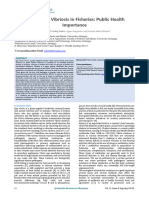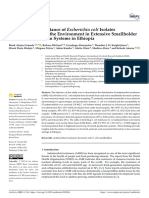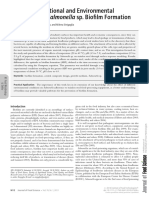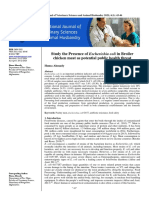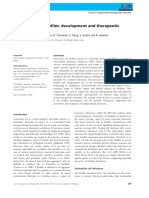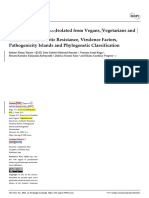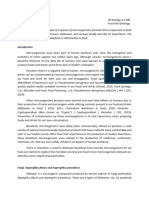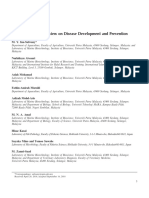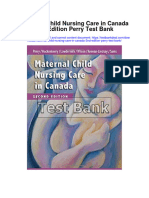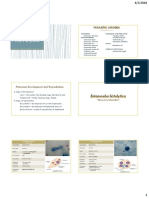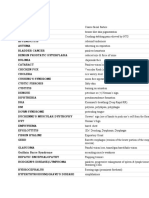Professional Documents
Culture Documents
Significance of Biofilm Formation by Enteric Escherichia Coli Obtained From Fresh Produce in Increased Antimicrobial Resistance and Persistence
Copyright
Available Formats
Share this document
Did you find this document useful?
Is this content inappropriate?
Report this DocumentCopyright:
Available Formats
Significance of Biofilm Formation by Enteric Escherichia Coli Obtained From Fresh Produce in Increased Antimicrobial Resistance and Persistence
Copyright:
Available Formats
Volume 8, Issue 5, May – 2023 International Journal of Innovative Science and Research Technology
ISSN No:-2456-2165
Significance of Biofilm Formation by Enteric
Escherichia Coli Obtained from Fresh Produce in
Increased Antimicrobial Resistance and Persistence
Dr. Rekha Mehrotra, Dr. Vijay Veer Saharan
Associate Professor, Department of Microbiology Department of Microbiology,
Shaheed Rajguru College of Applied Sciences for Women, School of Life Sciences, Central University of Rajasthan,
University of Delhi, Vasundhara Enclave, New Delhi, India NH-8, Bandar Sindri, Ajmer, Rajasthan, India-305817
Dr. Preeti Verma, Assistant Professor,
Department of Microbiology
Shaheed Rajguru College of Applied Sciences for Women, University of Delhi, Vasundhara Enclave, New Delhi, India
Abstract:- The risk of enteric pathogen contamination I. INTRODUCTION
and growth on fresh produce is one of the main safety
concerns associated with the increasing number of With major advancements in various aspects of
foodborne outbreaks in recent years. Plants in general biological applications and technology, people around the
are not considered as host for enteric pathogens. world are still affected and falling ill from consumption of
However, the increased persistence of pathogenic and contaminated food with exerting heavy toll on both human
commensal E. coli in plants has led to the consideration health and nation’s economy. This is not only the case in
of these fresh produce as a secondary reservoir although developing countries with lack of proper sanitation and
factors associated in the increased persistence are not health but also in developed countries [1]. Human food
very clear. Biofilms formation by pathogenic E. coli and borne infections traditionally are acquired through the
other Enterobacter pose a serious threat to the safety of ingestion of foods of animal origin. Fresh fruits and
fresh produce as they can persist and colonize for long vegetables have emerged as new vehicles for the
periods of time in the food processing environment and transmission of diseases [2]. Leafy green vegetables
thus represent a source of recurrent contamination. (cabbage, spinach, lettuce, carrot and salad leaves of all
Concurrently, increased antibiotic resistance is equally a variety) have been identified as commodity group of highest
major concern with respect to biofilm formation as these concern in view of microbiological safety. Pathogenic E.
factors aids in the enhanced levels of virulence, coli, Salmonella sp. and Enteric bacteria are involved in
persistence and colonization of the pathogenic E. coli in food borne outbreaks causing gastroenteritis and chronic
fresh produce. In the present study the biofilm infection [3]. E. coli infection arising from contaminated
formation, antibiotic resistance and the multicellular food continues to be an immense problem with millions of
behavior by pathogenic/non-pathogenic E. coli strains cases occurring annually throughout the world [4]. In
derived from fresh produce has been investigated. The addition to the misery caused, financial loss is enormous.
formation of biofilm and its associated role with
antibiotic resistance has been addressed unveiling the Fresh vegetables are fundamental components of the
importance of factors leading to an increased host – human diet and there is considerable evidence of the health
microbe interaction. A total number of 33 E. coli strains and nutritional benefits associated with the consumption of
were isolated from ready- to- eat fresh produce. The fresh vegetables. This has led to significant rise in the
obtained results confirmed the ability to form biofilm by demand of fresh produce, changes in life styles and major
the E. coli strains obtained from fresh produce. Most of shifts in consumption trends [5]. Vegetables can become
the E. coli with increased number of cellulose/curli- contaminated with microorganisms capable of causing
fimbriae production was able to form stronger biofilm human diseases while still on the fields. The primary source
and showed a significant number of antibiotic of transmission of pathogenic E. coli to human is through
resistances. Overall, the present study suggests a contaminated foods consumption such as raw or
correlation between biofilm formation and antibiotic undercooked ground meat products, fresh produce and raw
resistance, implicating its important role in the food milk [6]. Cross contamination during preparations and poor
borne intoxications and increased virulence and its storage facilities along with contamination of water and
potential relevance for the management of food-borne other foods leads to increased infection.
illnesses linked with consumption of fresh produce.
In India, the burden of food-borne disease is unclear.
Keywords:- E. Coli, Fresh Produce, Biofilm, Curli- Most food-borne diseases go unreported, only few are
Fimbriae, Cellulose, Antimicrobial Resistance. reported by the media, usually those with high morbidity
IJISRT23MAY956 www.ijisrt.com 715
Volume 8, Issue 5, May – 2023 International Journal of Innovative Science and Research Technology
ISSN No:-2456-2165
and/or occurring in urban areas [7, 8]. In the South-East BDAR (brown, dry and rough) indicating the expression of
Asia Region, WHO report shows nearly 150 million people curli-fimbriae only; d), SAW (smooth and white) indicating
fell ill with food borne diseases in 2010, which led to 175 no production of cellulose and curli-fimbriae. The distinct
000 deaths. Of these, 40% of food borne diseases burden colony morphotypes such as BDAR and RDAR have been
was among children under 5 years. reported in E. coli and Salmonella strains isolated from
clinical and animal sources [14, 15]. The BDAR and RDAR
Generally, it is considered that non-hosts morphotypes of Salmonella has been linked to increase their
environments such as plants do not support the colonization virulence or tolerance in long-term desiccation and nutrient
and survival of human enteric pathogens. However, depletion in biofilm [16]. However, limited information is
continuous increases in the microbial contamination of available on the role of production of curli fimbriae and
agricultural plants indicate that human enteric bacteria are cellulose and related colony morphotypes in agricultural
able to colonize and survive in fresh produce during plant-related E. coli and Salmonella.
cultivation and post-harvest processing [9, 10]. Further,
foodborne bacteria pathogens such as E. coli and Salmonella The present study focuses on the occurrence and
not only colonize or survive on the agricultural plant formation of biofilm as one of the approaches for
surface, but grow until the fresh produce is consumed by a colonization and persistence of enteric bacteria in fresh
new host. The most important strategies used by E. coli and produce with enhanced antimicrobial resistance.
Salmonella and other enteric bacteria during colonization or
survival in the agricultural plants is the formation of biofilm II. MATERIAL AND METHODS
[11]. A biofilm is an assembled and structural organization
of bacterial cells confined within a matrix of the EPS Recovery and Isolation of E. Coli from Fresh Produce:
(extracellular polymeric substance) and which adhere to a The ready to eat fresh produce samples (n=170): leafy
living or inert surface. Several studies have demonstrated greens, carrot, radish, lettuce, cucumber and tomato were
that biofilm formation is significantly associated with E. brought to laboratory from various local markets of New
coli and Salmonella strains isolated from different sources Delhi (India) aseptically in sterile plastic containers. All
such as clinical and animal [12]. Biofilm formation samples were collected, labelled and transported to the
behaviors of many bacteria including E. coli is significantly laboratory aseptically. Bacteriological analysis of each
associated to enhance survival in natural environments, collected sample was carried out on the same day.
resistance to antimicrobial agents and during interaction
with hosts. Recently, few studies indicate that E. coli and For the recovery of E. coli from the collected samples,
Salmonella and other foodborne bacteria pathogens are able previously described methods were used with slight
to form biofilm on the surface of plants as well as in inner modifications. Presumptive identification of the produce
spaces of the plant tissues. It is also believed that bacterial isolated E. coli was done by conventional microbiological
cells confined in biofilm are more resistant to antibiotics and methods such as Gram’s staining and biochemical
stress conditions [13, 14]. Curli is a major component of characterization was performed to further characterize the
biofilm in many enteric bacteria including E. coli and are isolates such as IMViC, oxidase test and catalase test.
important for adherence to different biotic and abiotic Additionally, E. coli strains using molecular methods were
surfaces [15]. Thus, it is considered that biofilm formation screened and identified for the presence of uidA gene, Shiga
is a survival strategy of E. coli and Salmonella to withstand toxin (stx) and intimin gene (eae) by PCR assay. STEC
on the surfaces of the agricultural plant under unfavorable were identified using PCR primers targeting stx1, stx2, and
conditions. The production of curli fimbriae or thin eae genes, as described previously [17].
aggregative fimbriae and cellulose in E. coli was found to be
important components in the formation of extracellular Biofilm Formation Assay:
polymeric matrix, which is essential during biofilm The biofilm development ability of the isolated E. coli
formation and persistence in various surfaces. Previous isolates was determined by using the microtiter plate method
studies suggest that production of curli fimbriae and as previously described [18]. The overnight growth of each
cellulose may be associated with the survival and bacterial strain with an OD600 of ⁓1.0 was diluted 1: 100 in
persistence of E. coli and Salmonella in the food fresh PBS and 200μl of the culture was added into the
environment. Evidences also suggest that production of triplicate well and incubated at 370C for 48 h. Culture was
cellulose and curli-fimbriae also offers protection to withdrawn, and each well was washed twice with sterile
bacterial cells against harsh environmental conditions such distilled water. The plates were air-dried, heat-fixed (60°C
as desiccation, osmotic shock, and UV radiation [13, 14]. for 2 hours), and stained with crystal violet (0.2%) for 10
Conversely, expression of cellulose and curli-fimbriae in E. min. The wells were washed twice to remove extra stain with
coli associated with their initial attachment in animal hosts distill water, air dried and solubilized in 200μl of 95%
or provides a physical barrier against the transmission of ethanol. Absorbance was obtained at OD570 . Wells
antimicrobial agents and compounds of the host immune containing only sterile media without bacterial inoculation
response. On the basis of the production of curli fimbriae were taken as blank or negative control.
and cellulose, E. coli displayed different colony
morphotypes; RDAR (red, dry and rough), indicating the
production of cellulose and curli; b), PDAR (pink, dry and
rough) indicating the production of cellulose only; c),
IJISRT23MAY956 www.ijisrt.com 716
Volume 8, Issue 5, May – 2023 International Journal of Innovative Science and Research Technology
ISSN No:-2456-2165
Cellulose and Curli Fimbriae Morphotype Screening:
The production of cellulose and curli-fimbria by all E.
coli strains was assessed using colony morphotypes on
congo red (CR) agar plates as described previously [13, 15].
Overnight grown fresh bacterial culture was inoculated on
CR agar plates prepared with LB agar without salt as a base
and supplemented with 40 μg/ml Congo red dye and 20
μg/ml of Coomassie brilliant blue and incubated at 25-28oC
for 72 hrs. Colony morphologies on CR plates were scored
as RDAR (Red Dry and Rough, indicates the expression of
both curli fimbriae and cellulose); BDAR (Brown Dry and
Rough, indicates the expression of curli-fimbriae only);
PDAR (Pink Dry and Rough, indicates the expression of
cellulose only); SAW (Smooth and White, indicates the no
expression of curli-fimbriae nor cellulose). The screening
experiment was performed in duplicates and at least 50-100
colonies per isolate was observed of each morphotype for
examination.
Antimicrobial Susceptibility Testing: Fig 2 Percentage Recovery of E. Coli Colonize and Persist
Antimicrobial susceptibility of obtained E. coli in Vegetables/Fruits
isolates was determined using the Kirby-Bauer disc
diffusion method on MHA medium according to the The PCR analysis of the recovered enteric E. coli was
Clinical and Laboratory Standards Institute (CLSI 2012). performed for the confirmation of the isolated strains. The
The antimicrobial susceptibility was tested against seven diagnostic gene uidA encoding beta-glucuronidase in most
classes of drugs comprising of total 16 antibiotics. of the E. coli were used for analysis. Among the 36 picked
Reference strains E. coli ATCC 25922 was used as control. isolates of presumptive E. coli 83% of the isolates showed
the presence of the uid gene (Fig 3). The number of isolates
III. RESULTS obtained by genotypic analysis was less as compared to
phenotypic analysis. Hence 33 E. coli were identified using
Recovery and Isolation of E. Coli from Fresh Produce: both conventional and molecular methods that were used for
To understand the factors associated with E. coli further analysis.
persistence on plants/fresh produce, a total of 33 (12.2%)
isolates of E. coli were recovered among the 170 fresh ready
to eat vegetable samples (Fig 1) Most isolates were obtained
from leafy greens (spinach and parsley) followed by lettuce,
carrot and cucumber (Fig 2).
Fig 1 E. Coli Growth on EMB Agar Showing Green Sheen:
(A) E. Coli Isolated From Vegetable (Cucumber) And Fig 3 PCR Amplification of ‘Uida’ (143bp) Genes from Six
(B) E. Coli 25922 Control Representatives E Coil Isolates
IJISRT23MAY956 www.ijisrt.com 717
Volume 8, Issue 5, May – 2023 International Journal of Innovative Science and Research Technology
ISSN No:-2456-2165
Biofilm Formation: Prevalence of antibiotic resistance in Escherichia coli:
The elucidation of the biofilm formation was analyzed Among each class of antimicrobial drugs used in the
as described by Stepanović et al., 2000; the obtained data study, highest proportion of resistance was observed against
require the definition of the cut-off value that splits biofilm- quinolones (66.7%) followed by penicillin (36%) and
producing from non-biofilm-producing strains compared to aminoglycosides (28%). Carbapenem, macrolids and
negative control. According to the biofilm formation assays, cephalosporins showed moderate resistance 15%, 18% and
most of the produce-origin isolates were forming the strong 9% respectively. However, phenicol were 100% susceptible
biofilm. The OD570 for strong biofilm was observed to be in for the E. coli isolates. The drug resistance prevalence
the range of 0.408–0.854 for the E. coli isolates. The pattern of E. coli is represented, in Fig. 6. To summarize, E.
adherence ability of strains tested was classified into four coli, recovered isolates exhibited MDR pattern against
categories: strong biofilm producer, moderate biofilm majority of the critically and highly important antimicrobial
producer, weak biofilm producer, and no biofilm producer drugs (Fig. 7). It was observed that majority of the isolates
based upon the OD obtained. On the basis of the values showing MDR pattern were able to form strong biofilm.
defined, among the 33 isolates of E. coli, 55% (n = 18)
showed strong, 15% (n = 5) moderate, 18% (n = 6) weak
biofilm formation ability, while 12% (n = 4) were not able to
form biofilm. Statistically significant difference (P < 0.05)
was observed between biofilm producers categorized as
strong, moderate, weak or none (Fig. 4)
Fig 6 Percentage Prevalence of Antimicrobial Resistance of
E. Coli Against Clinically Important Antibiotic Classes
Fig 4 Biofilm Formation Ability of Vegitable/Fruit-Origin
Escherichia Coil Isolates (N=33), Strong Biofilm Producer
(N=18; 55%), Moderate Biofilm Producer (5; 15%),
Weak Biofilm Producer (6; 18%), and No-Biofilm
Producer (4;12%)
Cellulose and Curli Fimbriae Morphotype Screening:
The E. coli isolates screened for cellulose and curli
fimbriae showed distinct colony morphotypes distribution.
The cellulose and curli fimbriae occurrence are exhibited as
RDAR, PDAR, BDAR and SAW. The distribution of E. coli
showing multicellular behaviors was observed as RDAR (n
= 16), PDAR (n = 8), BDAR (n = 7) and SAW (n = 2) as
depicted in Fig 5.
Fig 7 Percentage Resistant E. Coli Isolates Against
Individual Antibiotic
IV. DISCUSSION
Survival of human enteric pathogens in plants and
formation of biofilm has led to increase in the number of
food borne illnesses. The main question arises is how these
human pathogens invade the fresh produce and after
invading not only survive inside the plant, vegetable or fruits
also behaves as a carrier of the particular pathogens to
Fig 5 RDAR (red, dry and rough), PDAR (pink, dry and human. In the present study, we observed the survival
rough), BDAR (brown, dry and rough), SAW (smooth and strategies adopted by the human enteric pathogens to
white). Each bar represents no of E. coli isolates for overcome the environmental adverse conditions to colonize
particular colony morphotype and persist in the plant’s habitat. The isolated E. coli
IJISRT23MAY956 www.ijisrt.com 718
Volume 8, Issue 5, May – 2023 International Journal of Innovative Science and Research Technology
ISSN No:-2456-2165
displayed multicellular behavior showing RDAR, BDAR, V. CONCLUSION
PDAR morphotype, which indicates the
expression/production of both or either of cellulose or curli- In conclusion, the present study suggests that fresh
fimbriae [12, 13]. Mechanisms involved in surface produce (leafy greens, ready-to-eat produce) are potential
attachment of human pathogens to plants are biofilm reservoirs or sources of multidrug-resistant E. coli strains.
formation, fimbriae, extracellular polysaccharide and Further, this study reports the prevalence and pattern of
presence of flagella. Curli fimbriae and cellulose are the correlation of Biofilm formation and MDR in E. coli
extracellular polysaccharide supposed to be linked with originating from fresh produce. The major limitation of the
biofilm formation, majorly found to be determinant of cell- present study is that the analysis relied on phenotypic
cell interactions and adherence to biotic and abiotic surfaces. resistance data. Therefore, we did not have the opportunity
The occurrence of high number of RDAR morphotype in our to account for the multiple genetic determinants that
studies signifies the importance of cell adhesion to the plant underlie drug resistance. Despite this limitation, our study
surface. This is in agreement with the previous studies which represents an important contribution to providing a large
showed that cellulose and thin aggregative fimbriae are data set to identify E. coli, in particular to characterize the
important for E. coli interaction with plants [19, 20]. The level and dynamics of biofilm formation and antimicrobial
distinct colony morphotypes such as RDAR and BDAR have resistance in these pathogens present in leafy greens/fresh
also been reported in E. coli strains isolated from clinical and produce.
animal sources. Studies have shown increased survivability
of the E. coli possessing RDAR morphotype. Interestingly, ACKNOWLEDGMENT
E. coli isolates in our collection majorly displayed RDAR
and BDAR morphotypes, which suggests of their survival in The authors would like to thank the management of
the plant environment with virulence potential. A similar Shaheed Rajguru College of Applied Science for Women,
significant finding has been reported in E. coli isolated from University of Delhi, for providing facilities for carrying out
human gastrointestinal tract [12, 13]. Moreover, it has also the present study.
been shown that on plant surface the biofilm formation is
facilitated by the expression/production of cellulose and REFERENCES
curli-fimbriae by E. coli [12, 20]. Biofilms have a significant
value associated with public health as it aids in high [1]. Callejón, R.M., Rodríguez-Naranjo, M.I., Ubeda, C.,
resistance towards antibiotics [21]. Persistence of Hornedo-Ortega, R., Garcia-Parrilla, M.C. and
antimicrobial resistance in human pathogens associated in Troncoso, A.M., 2015. Reported foodborne outbreaks
agricultural produce has an important role in human health as due to fresh produce in the United States and
well as transfer of these antimicrobial resistance to other European Union: trends and causes. Foodborne
pathogens or local plant microbiota through horizontal gene pathogens and disease, 12(1), pp.32-38.
transfer [22]. In our study we determined human enteric [2]. Brandl, M.T., 2006. Fitness of human enteric
pathogens forming strong biofilms, 55% of E. coli isolates pathogens on plants and implications for food
were having strong biofilm forming ability. Biofilm safety. Annu. Rev. Phytopathol., 44, pp.367-392.
formation in food industry is a serious concern as this [3]. Holden, N., Pritchard, L. and Toth, I., 2009.
attachment of the pathogens to the vegetables and fruits are Colonization outwith the colon: plants as an
quite difficult and leading to illness. Our results of alternative environmental reservoir for human
correlation between colony morphotypes, biofilm formation pathogenic enterobacteria. FEMS Microbiology
and antibiotic resistance also suggest that the expression/ Reviews, 33(4), pp.689-703.
production of cellulose and curli-fimbriae are implicated in [4]. Painter, J.A., Hoekstra, R.M., Ayers, T., Tauxe, R.V.,
biofilm formation and strong biofilm formation facilitates Braden, C.R., Angulo, F.J. and Griffin, P.M., 2013.
enhanced antibiotic resistance. Studies have shown that Attribution of foodborne illnesses, hospitalizations,
antibiotic resistance is significantly associated with enhanced and deaths to food commodities by using outbreak
biofilm formation [23]. The EPS production during biofilm data, United States, 1998–2008. Emerging infectious
formation prevent the exposure of antibiotics to the E. coli diseases, 19(3), p.407.
isolates and further increasing the possibility of genetic [5]. Slavin, J.L. and Lloyd, B., Health benefits of fruits
exchange among the consortium in the biofilm formed and vegetables. Adv Nutr 2012; 3 (4): 506-516.
environment along with pathogenic and non-pathogenic [6]. Yang, S.C., Lin, C.H., Aljuffali, I.A. and Fang, J.Y.,
bacterial isolates. The bacteria form biofilm along with the 2017. Current pathogenic Escherichia coli foodborne
other bacterial communities and create a favorable niche that outbreak cases and therapy development. Archives of
protects it from the adverse environment conditions. Various microbiology, 199, pp.811-825.
material such as cellulose and curli fimbriae helps in the [7]. Pande, T.K., Khan, A.H., Pipersania, R., Sethi, S.K.
attachment to the plant surface. These molecules present in and Rath, Y., 2002. Watermelon
bacteria helps in easy attachment and mask the molecules of poisoning. Postgraduate Medical Journal, 78(916),
the plant. Taken together, our results strongly suggest that pp.124-125.
biofilm formation along with expression/production of [8]. Kunwar, R., Singh, H., Mangla, V. and Hiremath, R.,
cellulose and curli fimbriae are involved in the colonization 2013. Outbreak investigation: Salmonella food
and survival of E. coli in plants with significantly increased poisoning. medical journal armed forces india, 69(4),
antibiotic resistance. pp.388-391.
IJISRT23MAY956 www.ijisrt.com 719
Volume 8, Issue 5, May – 2023 International Journal of Innovative Science and Research Technology
ISSN No:-2456-2165
[9]. Kisluk, G. and Yaron, S., 2012. Presence and [22]. Thanner, S., Drissner, D. and Walsh, F., 2016.
persistence of Salmonella enterica serotype Antimicrobial resistance in agriculture. MBio, 7(2),
Typhimurium in the phyllosphere and rhizosphere of pp.e02227-15.
spray-irrigated parsley. Applied and environmental [23]. Bhardwaj, D.K., Taneja, N.K., Shivaprasad, D.P.,
microbiology, 78(11), pp.4030-4036. Chakotiya, A., Patel, P., Taneja, P., Sachdev, D.,
[10]. Olaimat, A.N. and Holley, R.A., 2012. Factors Gupta, S. and Sanal, M.G., 2021. Phenotypic and
influencing the microbial safety of fresh produce: a genotypic characterization of biofilm forming,
review. Food microbiology, 32(1), pp.1-19. antimicrobial resistant, pathogenic Escherichia coli
[11]. Mann, R., Holmes, A., McNeilly, O., Cavaliere, R., isolated from Indian dairy and meat
Sotiriou, G.A., Rice, S.A. and Gunawan, C., 2021. products. International Journal of Food
Evolution of biofilm-forming pathogenic bacteria in Microbiology, 336, p.108899.
the presence of nanoparticles and antibiotic:
adaptation phenomena and cross-resistance. Journal
of nanobiotechnology, 19(1), pp.1-17.
[12]. Solomon, E.B., Niemira, B.A., Sapers, G.M. and
Annous, B.A., 2005. Biofilm formation, cellulose
production, and curli biosynthesis by Salmonella
originating from produce, animal, and clinical
sources. Journal of food protection, 68(5), pp.906-
912.
[13]. Yaron, S. and Römling, U., 2014. Biofilm formation
by enteric pathogens and its role in plant colonization
and persistence. Microbial biotechnology, 7(6),
pp.496-516.
[14]. Flemming, H.C., Wingender, J., Szewzyk, U.,
Steinberg, P., Rice, S.A. and Kjelleberg, S., 2016.
Biofilms: an emergent form of bacterial life. Nature
Reviews Microbiology, 14(9), pp.563-575.
[15]. Bokranz, W., Wang, X., Tschäpe, H. and Römling,
U., 2005. Expression of cellulose and curli fimbriae
by Escherichia coli isolated from the gastrointestinal
tract. Journal of Medical Microbiology, 54(12),
pp.1171-1182..
[16]. Vestby, L.K., Møretrø, T., Ballance, S., Langsrud, S.
and Nesse, L.L., 2009. Survival potential of wild type
cellulose deficient Salmonella from the feed
industry. BMC veterinary research, 5, pp.1-10.
[17]. Ibekwe, A.M. and Grieve, C.M., 2003. Detection and
quantification of Escherichia coli O157: H7 in
environmental samples by real‐time PCR. Journal of
applied microbiology, 94(3), pp.421-431.
[18]. Stepanović, S., Vuković, D., Dakić, I., Savić, B. and
Švabić-Vlahović, M., 2000. A modified microtiter-
plate test for quantification of staphylococcal biofilm
formation. Journal of microbiological
methods, 40(2), pp.175-179.
[19]. Jain, S. and Chen, J., 2007. Attachment and biofilm
formation by various serotypes of Salmonella as
influenced by cellulose production and thin
aggregative fimbriae biosynthesis. Journal of food
protection, 70(11), pp.2473-2479.
[20]. Méric, G., Kemsley, E.K., Falush, D., Saggers, E.J.
and Lucchini, S., 2013. Phylogenetic distribution of
traits associated with plant colonization in E
scherichia coli. Environmental microbiology, 15(2),
pp.487-501.
[21]. Madani, A., Esfandiari, Z., Shoaei, P. and Ataei, B.,
2022. Evaluation of Virulence Factors, Antibiotic
Resistance, and Biofilm Formation of Escherichia
coli Isolated from Milk and Dairy Products in
Isfahan, Iran. Foods, 11(7), p.960..
IJISRT23MAY956 www.ijisrt.com 720
You might also like
- Overview On Mechanisms of Antibacterial Resistance: Alemayehu Toma, Serawit DeynoDocument10 pagesOverview On Mechanisms of Antibacterial Resistance: Alemayehu Toma, Serawit DeynowaelNo ratings yet
- Hygiene and Infection QuizDocument8 pagesHygiene and Infection QuizTanneka JacksonNo ratings yet
- Community Health Nursing Concept II - HandoutsDocument25 pagesCommunity Health Nursing Concept II - HandoutsDherick Rosas100% (1)
- Microbial Contamination of Ready-To-Eat Fresh Produce by Human Enteric Pathogens The Global Burden of Foodborne DiseasesDocument8 pagesMicrobial Contamination of Ready-To-Eat Fresh Produce by Human Enteric Pathogens The Global Burden of Foodborne DiseasesInternational Journal of Innovative Science and Research TechnologyNo ratings yet
- Advances and Future Prospects of Enzyme-Based Biofilm Prevention Approaches in The Food IndustryDocument19 pagesAdvances and Future Prospects of Enzyme-Based Biofilm Prevention Approaches in The Food IndustryhnphnphucNo ratings yet
- Investigation of Alternative Biocidal Options Against Foodborne Multidrug Resistant Pathogens 2020 MayDocument10 pagesInvestigation of Alternative Biocidal Options Against Foodborne Multidrug Resistant Pathogens 2020 MayWill XiaNo ratings yet
- Antibiotics 10 00372 v2Document2 pagesAntibiotics 10 00372 v2Ali RazaNo ratings yet
- A Comprehensive Review On The Development of Salmonella Biofilm On Gallbladder SurfaceDocument10 pagesA Comprehensive Review On The Development of Salmonella Biofilm On Gallbladder SurfaceInternational Journal of Innovative Science and Research TechnologyNo ratings yet
- Molecules 28 01154Document18 pagesMolecules 28 01154Stathis GiaourisNo ratings yet
- A review of vibriosis in fisheries - Public health importance (Review, 2020)Document9 pagesA review of vibriosis in fisheries - Public health importance (Review, 2020)evidencias2022 sersenaNo ratings yet
- Antimicrobial Resistance of Escherichia Coli IsolaDocument15 pagesAntimicrobial Resistance of Escherichia Coli IsolaGracelight LimitedNo ratings yet
- 395-404 5.55.15 PM 6.22.13 PM 6.23.17 PMDocument10 pages395-404 5.55.15 PM 6.22.13 PM 6.23.17 PMSaiful AbdulNo ratings yet
- Antibiotics 11 01324 v2Document16 pagesAntibiotics 11 01324 v2LarcNo ratings yet
- Antibiotic Resistance Genes in BacteriaDocument22 pagesAntibiotic Resistance Genes in BacteriaGabriel TrevisanNo ratings yet
- Escherichia Coli Isolated From Vegans, Vegetarians and Omnivores: Antibiotic Resistance, Virulence Factors, Pathogenicity Islands and Phylogenetic ClassificationDocument11 pagesEscherichia Coli Isolated From Vegans, Vegetarians and Omnivores: Antibiotic Resistance, Virulence Factors, Pathogenicity Islands and Phylogenetic ClassificationJoão Gabriel SonciniNo ratings yet
- E.coli ContaminationDocument4 pagesE.coli ContaminationNecka AmoloNo ratings yet
- The Scourge of Antibiotic Resistance: The Important Role of The EnvironmentDocument7 pagesThe Scourge of Antibiotic Resistance: The Important Role of The EnvironmentMaulida 04No ratings yet
- Prevalence and Antimicrobial Susceptibility of Escherichia Coli and Salmonella Isolates From Feedslitter and Cloacal Swabs From BRDocument14 pagesPrevalence and Antimicrobial Susceptibility of Escherichia Coli and Salmonella Isolates From Feedslitter and Cloacal Swabs From BRakpanemmanuel8No ratings yet
- Bacteriophage in Food SafetyDocument6 pagesBacteriophage in Food SafetySiti Najiha NasahruddinNo ratings yet
- Uyttendaele 2015Document21 pagesUyttendaele 2015transperantfxstudentNo ratings yet
- 1 s2.0 S0168160514002013 Main PDFDocument10 pages1 s2.0 S0168160514002013 Main PDFHiuyan ZhongNo ratings yet
- Artigo NutriçãoDocument4 pagesArtigo Nutriçãoannakah18No ratings yet
- Abstract-WPS OfficeDocument36 pagesAbstract-WPS OfficetmariamyididiyaNo ratings yet
- Emerging Microbial Biocontrol Strategies For Plant PathogensDocument10 pagesEmerging Microbial Biocontrol Strategies For Plant PathogensAlex PradoNo ratings yet
- Foods: Predictive Modeling of Microbial Behavior in FoodDocument16 pagesFoods: Predictive Modeling of Microbial Behavior in FoodĐăng LưuNo ratings yet
- Effects of Nutritional & Environmental Conditions on Salmonella sp. Biofilm FormationDocument5 pagesEffects of Nutritional & Environmental Conditions on Salmonella sp. Biofilm FormationelNo ratings yet
- Keynote Symposium: Tomorrow's Poultry: Sustainability and SafetyDocument3 pagesKeynote Symposium: Tomorrow's Poultry: Sustainability and SafetyRiza FahrifiNo ratings yet
- Antimicrobial Resistance and Biofilm Formation of Escherichia 2023Document22 pagesAntimicrobial Resistance and Biofilm Formation of Escherichia 2023ЯнаИлиеваNo ratings yet
- Prevalence and Characterization of Salmonella Isolated From Vegetables Salads and Ready To Eat Raw Mixed Vegetable Salads in Abidjan, Côte D'ivoireDocument11 pagesPrevalence and Characterization of Salmonella Isolated From Vegetables Salads and Ready To Eat Raw Mixed Vegetable Salads in Abidjan, Côte D'ivoireSandraNo ratings yet
- Food Microbiology: Nicol Janecko, Roxana Zamudio, Rapha Elle Palau, Samuel J. Bloomfield, Alison E. MatherDocument12 pagesFood Microbiology: Nicol Janecko, Roxana Zamudio, Rapha Elle Palau, Samuel J. Bloomfield, Alison E. MatherDiana AlelíNo ratings yet
- Normal Flora Vs PathogenDocument5 pagesNormal Flora Vs PathogenYeni RahmawatiNo ratings yet
- MBO3 11 E1260Document23 pagesMBO3 11 E1260Valentina IorgaNo ratings yet
- Food Safety in India: A Public Health Priority: CommentaryDocument5 pagesFood Safety in India: A Public Health Priority: CommentaryShalli GorkaNo ratings yet
- Study The Presence of Escherichia Coli in Broiler Chicken Meat As Potential Public Health ThreatDocument4 pagesStudy The Presence of Escherichia Coli in Broiler Chicken Meat As Potential Public Health ThreatHuma AhmadyNo ratings yet
- PIIS2405844018374966Document21 pagesPIIS2405844018374966Nadia Islam AkshaNo ratings yet
- Animals 11 03431 v2Document20 pagesAnimals 11 03431 v2bhadraiahNo ratings yet
- Karan 2021Document18 pagesKaran 2021hugoNo ratings yet
- Asian Journal of Pharmaceutical and Health SciencesDocument6 pagesAsian Journal of Pharmaceutical and Health SciencesadesidasolaNo ratings yet
- Sharma Et Al-2016-Journal of Applied MicrobiologyDocument11 pagesSharma Et Al-2016-Journal of Applied MicrobiologyJoanaNo ratings yet
- Solis2002 PDFDocument3 pagesSolis2002 PDFandre yusekaNo ratings yet
- 1 s2.0 S0362028X22018543 MainDocument4 pages1 s2.0 S0362028X22018543 MainVNo ratings yet
- Atterbury 2011Document10 pagesAtterbury 2011Alex Cristian IonutNo ratings yet
- Water Quality and Antimicrobial Resistant Profile of Escherichia Coli Isolated From Dug Wells Used For Domestic PurposesDocument9 pagesWater Quality and Antimicrobial Resistant Profile of Escherichia Coli Isolated From Dug Wells Used For Domestic PurposesIJPHSNo ratings yet
- Jurnal Internasional Kromatografi KolomDocument6 pagesJurnal Internasional Kromatografi KolomRiza FaelasshofaNo ratings yet
- Manuscript v6Document13 pagesManuscript v6João Gabriel SonciniNo ratings yet
- Evaluation of Microbiological Safety of Organic and Conventionally Grown RiceDocument7 pagesEvaluation of Microbiological Safety of Organic and Conventionally Grown RiceAdinda MahardikaNo ratings yet
- Foods 12 04502Document17 pagesFoods 12 04502Stathis GiaourisNo ratings yet
- Ijerph 15 00617Document19 pagesIjerph 15 00617arieftamaNo ratings yet
- Foods 12 02893Document14 pagesFoods 12 02893Stathis GiaourisNo ratings yet
- Antibiotic Susceptibility Testing (AST) Reports: A Basis For Environmental Surveillance and Infection Control Amongst Environmental Vibrio CholeraeDocument23 pagesAntibiotic Susceptibility Testing (AST) Reports: A Basis For Environmental Surveillance and Infection Control Amongst Environmental Vibrio CholeraeMaulidina AmaliaNo ratings yet
- Phagocytosis of Gut Bacteria by Entamoeba HistolyticaDocument9 pagesPhagocytosis of Gut Bacteria by Entamoeba Histolyticagwyneth.green.512No ratings yet
- Antonio - Long Exam 1Document6 pagesAntonio - Long Exam 1JazMine AntonioNo ratings yet
- The Relationship Between Cross Food Contamination and Foodborne Illness Due To Drug Resistant BacteriaDocument6 pagesThe Relationship Between Cross Food Contamination and Foodborne Illness Due To Drug Resistant BacteriaHerald Scholarly Open AccessNo ratings yet
- Food Borne Diseases Jurnal1Document12 pagesFood Borne Diseases Jurnal1Indah SulistiyawatiNo ratings yet
- Isolation and Characterization of Bacteriophages Against Avian Pathogenic EDocument25 pagesIsolation and Characterization of Bacteriophages Against Avian Pathogenic Earoojfatema6No ratings yet
- Emerging Microbial Strategies Control Plant PathogensDocument46 pagesEmerging Microbial Strategies Control Plant PathogensNair GonzalezNo ratings yet
- Ina-Salwany Et Al 2019Document20 pagesIna-Salwany Et Al 2019jgabriellrLNo ratings yet
- Interactions Between Parasites and Human MicrobiotDocument6 pagesInteractions Between Parasites and Human MicrobiotGregorio De Las CasasNo ratings yet
- Antibiotic Resistant Bacteria in Raw Chicken Meat Sold in A Public Market in Quezon City, PhilippinesDocument9 pagesAntibiotic Resistant Bacteria in Raw Chicken Meat Sold in A Public Market in Quezon City, PhilippinesSantos1599No ratings yet
- Microbiota y Disbiosis (Taller 13)Document17 pagesMicrobiota y Disbiosis (Taller 13)Pamela PastenNo ratings yet
- International Research Journal of Microbiology 2011Document8 pagesInternational Research Journal of Microbiology 2011Maurilio Lara FloresNo ratings yet
- Microbial Safety of Fresh ProduceFrom EverandMicrobial Safety of Fresh ProduceXuetong FanNo ratings yet
- Visual Water: An Integration of App and Web to Understand Chemical ElementsDocument5 pagesVisual Water: An Integration of App and Web to Understand Chemical ElementsInternational Journal of Innovative Science and Research TechnologyNo ratings yet
- Parastomal Hernia: A Case Report, Repaired by Modified Laparascopic Sugarbaker TechniqueDocument2 pagesParastomal Hernia: A Case Report, Repaired by Modified Laparascopic Sugarbaker TechniqueInternational Journal of Innovative Science and Research TechnologyNo ratings yet
- Smart Cities: Boosting Economic Growth through Innovation and EfficiencyDocument19 pagesSmart Cities: Boosting Economic Growth through Innovation and EfficiencyInternational Journal of Innovative Science and Research TechnologyNo ratings yet
- Smart Health Care SystemDocument8 pagesSmart Health Care SystemInternational Journal of Innovative Science and Research TechnologyNo ratings yet
- Impact of Silver Nanoparticles Infused in Blood in a Stenosed Artery under the Effect of Magnetic Field Imp. of Silver Nano. Inf. in Blood in a Sten. Art. Under the Eff. of Mag. FieldDocument6 pagesImpact of Silver Nanoparticles Infused in Blood in a Stenosed Artery under the Effect of Magnetic Field Imp. of Silver Nano. Inf. in Blood in a Sten. Art. Under the Eff. of Mag. FieldInternational Journal of Innovative Science and Research TechnologyNo ratings yet
- Insights into Nipah Virus: A Review of Epidemiology, Pathogenesis, and Therapeutic AdvancesDocument8 pagesInsights into Nipah Virus: A Review of Epidemiology, Pathogenesis, and Therapeutic AdvancesInternational Journal of Innovative Science and Research TechnologyNo ratings yet
- An Analysis on Mental Health Issues among IndividualsDocument6 pagesAn Analysis on Mental Health Issues among IndividualsInternational Journal of Innovative Science and Research TechnologyNo ratings yet
- Implications of Adnexal Invasions in Primary Extramammary Paget’s Disease: A Systematic ReviewDocument6 pagesImplications of Adnexal Invasions in Primary Extramammary Paget’s Disease: A Systematic ReviewInternational Journal of Innovative Science and Research TechnologyNo ratings yet
- Compact and Wearable Ventilator System for Enhanced Patient CareDocument4 pagesCompact and Wearable Ventilator System for Enhanced Patient CareInternational Journal of Innovative Science and Research TechnologyNo ratings yet
- The Relationship between Teacher Reflective Practice and Students Engagement in the Public Elementary SchoolDocument31 pagesThe Relationship between Teacher Reflective Practice and Students Engagement in the Public Elementary SchoolInternational Journal of Innovative Science and Research TechnologyNo ratings yet
- Air Quality Index Prediction using Bi-LSTMDocument8 pagesAir Quality Index Prediction using Bi-LSTMInternational Journal of Innovative Science and Research TechnologyNo ratings yet
- Predict the Heart Attack Possibilities Using Machine LearningDocument2 pagesPredict the Heart Attack Possibilities Using Machine LearningInternational Journal of Innovative Science and Research TechnologyNo ratings yet
- The Utilization of Date Palm (Phoenix dactylifera) Leaf Fiber as a Main Component in Making an Improvised Water FilterDocument11 pagesThe Utilization of Date Palm (Phoenix dactylifera) Leaf Fiber as a Main Component in Making an Improvised Water FilterInternational Journal of Innovative Science and Research TechnologyNo ratings yet
- Parkinson’s Detection Using Voice Features and Spiral DrawingsDocument5 pagesParkinson’s Detection Using Voice Features and Spiral DrawingsInternational Journal of Innovative Science and Research TechnologyNo ratings yet
- Investigating Factors Influencing Employee Absenteeism: A Case Study of Secondary Schools in MuscatDocument16 pagesInvestigating Factors Influencing Employee Absenteeism: A Case Study of Secondary Schools in MuscatInternational Journal of Innovative Science and Research TechnologyNo ratings yet
- Harnessing Open Innovation for Translating Global Languages into Indian LanuagesDocument7 pagesHarnessing Open Innovation for Translating Global Languages into Indian LanuagesInternational Journal of Innovative Science and Research TechnologyNo ratings yet
- Exploring the Molecular Docking Interactions between the Polyherbal Formulation Ibadhychooranam and Human Aldose Reductase Enzyme as a Novel Approach for Investigating its Potential Efficacy in Management of CataractDocument7 pagesExploring the Molecular Docking Interactions between the Polyherbal Formulation Ibadhychooranam and Human Aldose Reductase Enzyme as a Novel Approach for Investigating its Potential Efficacy in Management of CataractInternational Journal of Innovative Science and Research TechnologyNo ratings yet
- Terracing as an Old-Style Scheme of Soil Water Preservation in Djingliya-Mandara Mountains- CameroonDocument14 pagesTerracing as an Old-Style Scheme of Soil Water Preservation in Djingliya-Mandara Mountains- CameroonInternational Journal of Innovative Science and Research TechnologyNo ratings yet
- Diabetic Retinopathy Stage Detection Using CNN and Inception V3Document9 pagesDiabetic Retinopathy Stage Detection Using CNN and Inception V3International Journal of Innovative Science and Research TechnologyNo ratings yet
- Dense Wavelength Division Multiplexing (DWDM) in IT Networks: A Leap Beyond Synchronous Digital Hierarchy (SDH)Document2 pagesDense Wavelength Division Multiplexing (DWDM) in IT Networks: A Leap Beyond Synchronous Digital Hierarchy (SDH)International Journal of Innovative Science and Research TechnologyNo ratings yet
- The Making of Object Recognition Eyeglasses for the Visually Impaired using Image AIDocument6 pagesThe Making of Object Recognition Eyeglasses for the Visually Impaired using Image AIInternational Journal of Innovative Science and Research TechnologyNo ratings yet
- Electro-Optics Properties of Intact Cocoa Beans based on Near Infrared TechnologyDocument7 pagesElectro-Optics Properties of Intact Cocoa Beans based on Near Infrared TechnologyInternational Journal of Innovative Science and Research TechnologyNo ratings yet
- Advancing Healthcare Predictions: Harnessing Machine Learning for Accurate Health Index PrognosisDocument8 pagesAdvancing Healthcare Predictions: Harnessing Machine Learning for Accurate Health Index PrognosisInternational Journal of Innovative Science and Research TechnologyNo ratings yet
- Design, Development and Evaluation of Methi-Shikakai Herbal ShampooDocument8 pagesDesign, Development and Evaluation of Methi-Shikakai Herbal ShampooInternational Journal of Innovative Science and Research Technology100% (3)
- Formulation and Evaluation of Poly Herbal Body ScrubDocument6 pagesFormulation and Evaluation of Poly Herbal Body ScrubInternational Journal of Innovative Science and Research TechnologyNo ratings yet
- The Impact of Digital Marketing Dimensions on Customer SatisfactionDocument6 pagesThe Impact of Digital Marketing Dimensions on Customer SatisfactionInternational Journal of Innovative Science and Research TechnologyNo ratings yet
- A Survey of the Plastic Waste used in Paving BlocksDocument4 pagesA Survey of the Plastic Waste used in Paving BlocksInternational Journal of Innovative Science and Research TechnologyNo ratings yet
- Comparatively Design and Analyze Elevated Rectangular Water Reservoir with and without Bracing for Different Stagging HeightDocument4 pagesComparatively Design and Analyze Elevated Rectangular Water Reservoir with and without Bracing for Different Stagging HeightInternational Journal of Innovative Science and Research TechnologyNo ratings yet
- Auto Encoder Driven Hybrid Pipelines for Image Deblurring using NAFNETDocument6 pagesAuto Encoder Driven Hybrid Pipelines for Image Deblurring using NAFNETInternational Journal of Innovative Science and Research TechnologyNo ratings yet
- Cyberbullying: Legal and Ethical Implications, Challenges and Opportunities for Policy DevelopmentDocument7 pagesCyberbullying: Legal and Ethical Implications, Challenges and Opportunities for Policy DevelopmentInternational Journal of Innovative Science and Research TechnologyNo ratings yet
- Guidelines On Hand HygieneDocument270 pagesGuidelines On Hand HygieneDr. Vikram Lotwala100% (1)
- Isolation and Identification of Bacteria From Lake Water in and Around Ranipet Area, Vellore DistrictDocument4 pagesIsolation and Identification of Bacteria From Lake Water in and Around Ranipet Area, Vellore DistrictDebjyotiDawnNo ratings yet
- Community Health Nusing Exam EditedDocument9 pagesCommunity Health Nusing Exam EditedRosebel LaguraNo ratings yet
- Tata Laksana PneumoniaDocument29 pagesTata Laksana PneumoniaSRI WIDOWATINo ratings yet
- Maternal Child Nursing Care in Canada 2Nd Edition Perry Test Bank Full Chapter PDFDocument36 pagesMaternal Child Nursing Care in Canada 2Nd Edition Perry Test Bank Full Chapter PDFChristopherHugheswpya100% (11)
- 10.1007@s10096 019 03768 9Document6 pages10.1007@s10096 019 03768 9Dany Daniel Rafael HuamanNo ratings yet
- Bio 204Document3 pagesBio 204adebolaabdulghalibNo ratings yet
- Lecture 4 PharmD 2022 Part IDocument15 pagesLecture 4 PharmD 2022 Part Iمنوعات عالميةNo ratings yet
- 9700 w11 QP 22Document12 pages9700 w11 QP 22Komathi BalasupramaniamNo ratings yet
- Artificial Intelligence For Coronavirus OutbreakDocument84 pagesArtificial Intelligence For Coronavirus OutbreakJose Antonio Ramos OliverNo ratings yet
- CHAPTER-1 Citrus MaximaDocument5 pagesCHAPTER-1 Citrus MaximaSarah VillaNo ratings yet
- The Body Hunters: Testings New Drugs On The World's Poorest Patients (PDFDrive)Document231 pagesThe Body Hunters: Testings New Drugs On The World's Poorest Patients (PDFDrive)Ange Fabrice N'DANo ratings yet
- Medical Parasitology PDFDocument33 pagesMedical Parasitology PDFRohan100% (1)
- Diesse Catalogo2023Document60 pagesDiesse Catalogo2023Nas simaNo ratings yet
- BLA CK DEA TH: Spanis H FluDocument24 pagesBLA CK DEA TH: Spanis H FluShiela FranciscoNo ratings yet
- QB - L03 - Fibre To Fabric - QPDocument3 pagesQB - L03 - Fibre To Fabric - QPPankaj SinghNo ratings yet
- Unit-04 Chemotherapy and Immunopharmacology (Answer Key)Document4 pagesUnit-04 Chemotherapy and Immunopharmacology (Answer Key)Saurabh Kumar Rawat100% (1)
- Hospital Acquired PneumoniaDocument21 pagesHospital Acquired PneumoniaNatashaDianasari100% (1)
- FUMSA GA Concept Draft JONATHANDocument7 pagesFUMSA GA Concept Draft JONATHANDeborah ChemutaiNo ratings yet
- Pathogenic Amoebae and TreatmentDocument14 pagesPathogenic Amoebae and TreatmentShine CalarananNo ratings yet
- Dr. Huda R. Sabbar Al-Anbar University College of Medicine: HaemoflagellatesDocument19 pagesDr. Huda R. Sabbar Al-Anbar University College of Medicine: HaemoflagellatesThunderNo ratings yet
- AmebiasisDocument14 pagesAmebiasisxxxchi chaxxxNo ratings yet
- Editorial: Cellular and Molecular Mechanisms of MycobacteriumDocument4 pagesEditorial: Cellular and Molecular Mechanisms of MycobacteriumJean.ZapataNo ratings yet
- Ds61-Symbiosis Practice Formative AssessmentDocument5 pagesDs61-Symbiosis Practice Formative Assessmentapi-110789702No ratings yet
- Biosafety and Universal Precautions in The LaboratoryDocument48 pagesBiosafety and Universal Precautions in The LaboratoryRosemary ShirimaNo ratings yet
- Disease Signs & SymptomsDocument3 pagesDisease Signs & SymptomsJose Dangali AlinaoNo ratings yet
- Week 4 CPH LEC - Introduction To Epidemiology: Fundamentals of Epidemiology in Public Health PracticeDocument11 pagesWeek 4 CPH LEC - Introduction To Epidemiology: Fundamentals of Epidemiology in Public Health PracticeQueency DangilanNo ratings yet
- Compare & Contrast Graphic OrganizerDocument3 pagesCompare & Contrast Graphic OrganizerMochi-chanNo ratings yet









